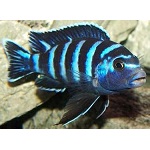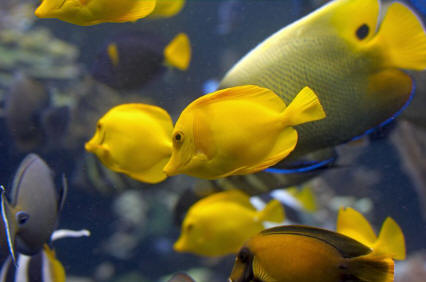Demasoni

|
Scientific Name: Pseudotropheus demasoni Price: Upon Request Origin: Africa - Lake Malawi Family: Cichlidae NOT AVAILABLE NOW |
|
Other Names: Demason's Cichlid, Demasoni Cichlid, Pseudotropheus demasoni |
|
Technical Info
Temperature: 24 - 28 ℃
pH: 7.8 - 8.5
GH: 20 - 26
Max size: 10 cm
Min Tank size: 190 Ltr
Position in Aqua: No special swimming level
Description
The male of this species has dark blue or black vertical stripes with alternating lighter stripes of light blue to white. The male Demasoni Cichlid also displays the typical spots on the anal fin, and is considerably larger than the female. The female of this species is not as brilliantly colored, and lacks the spots on the anal fin.
Food
Demasoni are vegetarians and should be fed foods high in spirulina and other vegetable content. A high quality all-purpose cichlid formula will also work as a staple food.
Breeding
Mouth-brooder. The fish is even more aggressive during spawning and you risk loosing a few fishes due to fighting. The female will brood for approximately 3 weeks. You can tell if a female is brooding by her enlarged mouth and the fact that she isnít eating. Fry accepts most kinds of food. Brooding females can be isolated for more productive breeding. It is recommendable to try to make the isolation as short as possible to avoid that the females loses their social status which may cause fights once they are returned. Stress might cause the females to eat eggs and fry. Some fry may survive in a community tank.
Compatible with
One of the most aggressive and territorial mbuna. It should not be kept with peace loving species such as Peacocks or Utaka but it can be combined with other robust mbuna, provided they do not resemble it in patterning. It has no fear and will attack fish several times it's own size. The tank should be overcrowded to reduce aggression and territory formation. It is incredibly aggressive towards others of the same species and the presence of heterospecifics helps to dissipate this. The other option is to keep it in an overcrowded tank with many of its own kind.
Note
A large aquarium with plenty of caves and hiding places is ideal for these fish. An aragonite-based substrate is recommended in order to maintain the necessary high pH and alkalinity.

